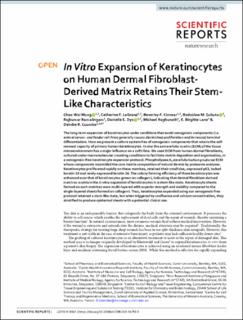Please use this identifier to cite or link to this item:
https://doi.org/10.21256/zhaw-22188Full metadata record
| DC Field | Value | Language |
|---|---|---|
| dc.contributor.author | Wong, Chee-Wai | - |
| dc.contributor.author | LeGrand, Catherine F. | - |
| dc.contributor.author | Kinnear, Beverley F. | - |
| dc.contributor.author | Sobota, Radoslaw M. | - |
| dc.contributor.author | Ramalingam, Rajkumar | - |
| dc.contributor.author | Dye, Danielle E. | - |
| dc.contributor.author | Raghunath, Michael | - |
| dc.contributor.author | Lane, E. Birgitte | - |
| dc.contributor.author | Coombe, Deirdre R. | - |
| dc.date.accessioned | 2021-03-26T15:19:38Z | - |
| dc.date.available | 2021-03-26T15:19:38Z | - |
| dc.date.issued | 2019-12-06 | - |
| dc.identifier.issn | 2045-2322 | de_CH |
| dc.identifier.uri | https://digitalcollection.zhaw.ch/handle/11475/22188 | - |
| dc.description.abstract | The long-term expansion of keratinocytes under conditions that avoid xenogeneic components (i.e. animal serum- and feeder cell-free) generally causes diminished proliferation and increased terminal differentiation. Here we present a culture system free of xenogeneic components that retains the self-renewal capacity of primary human keratinocytes. In vivo the extracellular matrix (ECM) of the tissue microenvironment has a major influence on a cell's fate. We used ECM from human dermal fibroblasts, cultured under macromolecular crowding conditions to facilitate matrix deposition and organisation, in a xenogeneic-free keratinocyte expansion protocol. Phospholipase A2 decellularisation produced ECM whose components resembled the core matrix composition of natural dermis by proteome analyses. Keratinocytes proliferated rapidly on these matrices, retained their small size, expressed p63, lacked keratin 10 and rarely expressed keratin 16. The colony forming efficiency of these keratinocytes was enhanced over that of keratinocytes grown on collagen I, indicating that dermal fibroblast-derived matrices maintain the in vitro expansion of keratinocytes in a stem-like state. Keratinocyte sheets formed on such matrices were multi-layered with superior strength and stability compared to the single-layered sheets formed on collagen I. Thus, keratinocytes expanded using our xenogeneic-free protocol retained a stem-like state, but when triggered by confluence and calcium concentration, they stratified to produce epidermal sheets with a potential clinical use. | de_CH |
| dc.language.iso | en | de_CH |
| dc.publisher | Nature Publishing Group | de_CH |
| dc.relation.ispartof | Scientific Reports | de_CH |
| dc.rights | http://creativecommons.org/licenses/by/4.0/ | de_CH |
| dc.subject | Cell culture technique | de_CH |
| dc.subject | Cell differentiation | de_CH |
| dc.subject | Cell proliferation | de_CH |
| dc.subject | Cultured cells | de_CH |
| dc.subject | Coculture technique | de_CH |
| dc.subject | Dermis | de_CH |
| dc.subject | Extracellular matrix | de_CH |
| dc.subject | Feeder cells | de_CH |
| dc.subject | Fibroblasts | de_CH |
| dc.subject | Human | de_CH |
| dc.subject | Keratinocytes | de_CH |
| dc.subject | Skin transplantation | de_CH |
| dc.subject.ddc | 610.28: Biomedizin, Biomedizinische Technik | de_CH |
| dc.title | In vitro expansion of keratinocytes on human dermal fibroblast-derived matrix retains their stem-like characteristics | de_CH |
| dc.type | Beitrag in wissenschaftlicher Zeitschrift | de_CH |
| dcterms.type | Text | de_CH |
| zhaw.departement | Life Sciences und Facility Management | de_CH |
| zhaw.organisationalunit | Institut für Chemie und Biotechnologie (ICBT) | de_CH |
| dc.identifier.doi | 10.1038/s41598-019-54793-9 | de_CH |
| dc.identifier.doi | 10.21256/zhaw-22188 | - |
| dc.identifier.pmid | 31811191 | de_CH |
| zhaw.funding.eu | No | de_CH |
| zhaw.issue | 1 | de_CH |
| zhaw.originated.zhaw | Yes | de_CH |
| zhaw.pages.start | 18561 | de_CH |
| zhaw.publication.status | publishedVersion | de_CH |
| zhaw.volume | 9 | de_CH |
| zhaw.publication.review | Peer review (Publikation) | de_CH |
| zhaw.author.additional | No | de_CH |
| zhaw.display.portrait | Yes | de_CH |
| Appears in collections: | Publikationen Life Sciences und Facility Management | |
Files in This Item:
| File | Description | Size | Format | |
|---|---|---|---|---|
| 2019_Wong-et-al_In-Vitro-expansion-of-Keratinocytes-on-Human-Dermal-fibroblast-Derived-Matrix .pdf | 4.16 MB | Adobe PDF |  View/Open |
Show simple item record
Wong, C.-W., LeGrand, C. F., Kinnear, B. F., Sobota, R. M., Ramalingam, R., Dye, D. E., Raghunath, M., Lane, E. B., & Coombe, D. R. (2019). In vitro expansion of keratinocytes on human dermal fibroblast-derived matrix retains their stem-like characteristics. Scientific Reports, 9(1), 18561. https://doi.org/10.1038/s41598-019-54793-9
Wong, C.-W. et al. (2019) ‘In vitro expansion of keratinocytes on human dermal fibroblast-derived matrix retains their stem-like characteristics’, Scientific Reports, 9(1), p. 18561. Available at: https://doi.org/10.1038/s41598-019-54793-9.
C.-W. Wong et al., “In vitro expansion of keratinocytes on human dermal fibroblast-derived matrix retains their stem-like characteristics,” Scientific Reports, vol. 9, no. 1, p. 18561, Dec. 2019, doi: 10.1038/s41598-019-54793-9.
WONG, Chee-Wai, Catherine F. LEGRAND, Beverley F. KINNEAR, Radoslaw M. SOBOTA, Rajkumar RAMALINGAM, Danielle E. DYE, Michael RAGHUNATH, E. Birgitte LANE und Deirdre R. COOMBE, 2019. In vitro expansion of keratinocytes on human dermal fibroblast-derived matrix retains their stem-like characteristics. Scientific Reports. 6 Dezember 2019. Bd. 9, Nr. 1, S. 18561. DOI 10.1038/s41598-019-54793-9
Wong, Chee-Wai, Catherine F. LeGrand, Beverley F. Kinnear, Radoslaw M. Sobota, Rajkumar Ramalingam, Danielle E. Dye, Michael Raghunath, E. Birgitte Lane, and Deirdre R. Coombe. 2019. “In Vitro Expansion of Keratinocytes on Human Dermal Fibroblast-Derived Matrix Retains Their Stem-like Characteristics.” Scientific Reports 9 (1): 18561. https://doi.org/10.1038/s41598-019-54793-9.
Wong, Chee-Wai, et al. “In Vitro Expansion of Keratinocytes on Human Dermal Fibroblast-Derived Matrix Retains Their Stem-like Characteristics.” Scientific Reports, vol. 9, no. 1, Dec. 2019, p. 18561, https://doi.org/10.1038/s41598-019-54793-9.
Items in DSpace are protected by copyright, with all rights reserved, unless otherwise indicated.